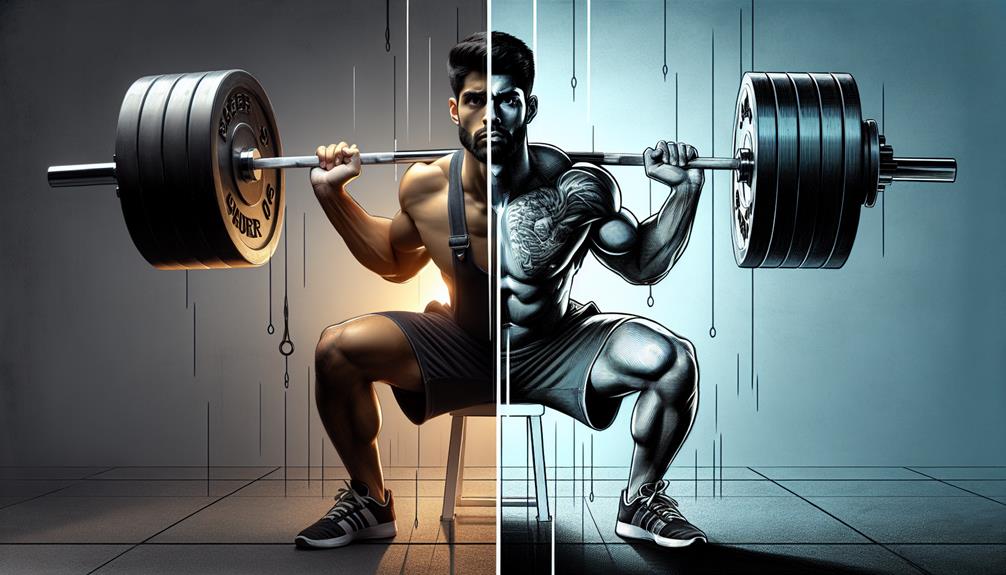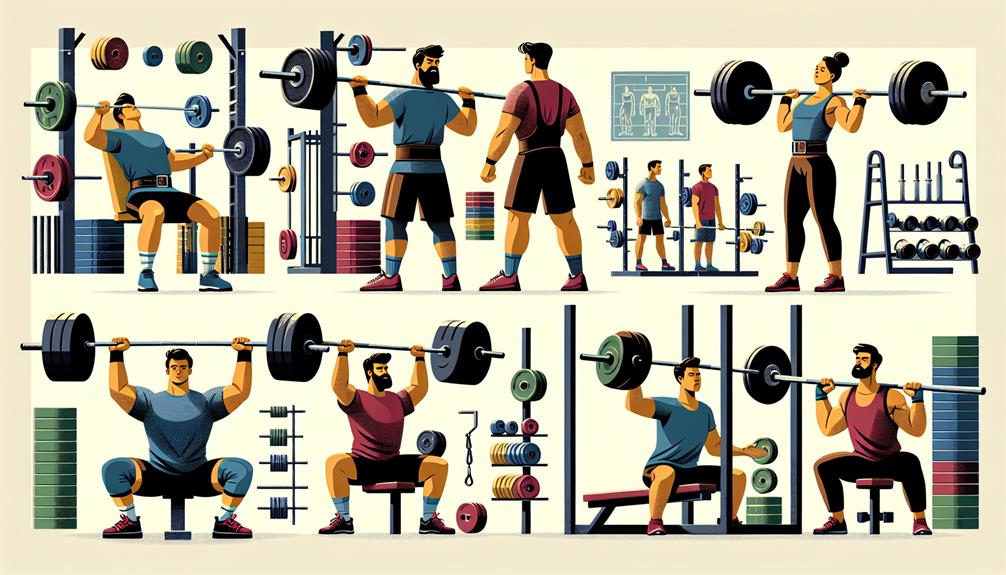When it comes to powerlifting training splits, the journey of discovering what truly suits you can be both enlightening and challenging. With various options like full-body workouts, upper/lower body splits, and push/pull/legs splits, the possibilities might seem overwhelming at first. However, finding the right training split is crucial for optimizing your performance and reaching your powerlifting goals. Experimenting with different splits and understanding how your body responds to each can lead you on a path to unlocking your full strength potential.
Key Takeaways
- Tailor your training split to match powerlifting goals and recovery needs.
- Customize for faster progress and better results in powerlifting.
- Experiment with full-body, upper/lower, or push/pull/legs splits.
- Focus on muscle balance, recovery, and specific powerlifting requirements.
Benefits of Different Training Splits
When considering powerlifting training splits, understanding the benefits of different approaches can help you optimize your workout routine for maximum gains. One common split is the Push-Pull-Legs (PPL) routine. This split focuses on specific muscle groups each day, allowing for adequate rest and recovery. PPL splits are effective for both strength gains and muscle hypertrophy as they provide ample time for each muscle group to be targeted with intensity.
Another popular split is the Upper-Lower routine. This split divides your workouts into upper body and lower body days, allowing you to target each area with more volume and focus. Upper-Lower splits are beneficial for building overall strength and muscle mass while providing a good balance between intensity and recovery.
Understanding the benefits of these different training splits can help you tailor your workouts to meet your specific goals. Whether you prioritize strength gains or muscle hypertrophy, choosing the right training split is key to maximizing your progress and achieving optimal results in your powerlifting journey.
Full-Body Workout Splits
Looking to maximize your training efficiency and target multiple muscle groups in each session? Full-body workout splits might be the answer for you. These training splits involve working all major muscle groups in one session, providing a comprehensive approach to strength training. Here's what you need to consider when incorporating full-body workout splits:
- Frequency Variations: Adjust the number of sessions per week based on your goals and recovery capacity.
- Balancing Priorities: Ensure you distribute the training volume evenly across different muscle groups to prevent overtraining or underdevelopment.
- Recovery Considerations: Adequate rest between sessions is crucial for muscle repair and growth. Listen to your body and adjust intensity levels as needed.
Full-body workout splits can be a practical option for individuals looking to balance their training priorities while optimizing recovery and intensity levels. Experiment with different frequencies and exercises to find the best approach that works for your body and goals.
Upper/Lower Body Splits

For a balanced approach to strength training that targets both your upper and lower body, consider incorporating Upper/Lower Body Splits into your workout routine. This training split involves dividing your weekly workouts into sessions that focus on either the upper body or the lower body. By doing so, you can effectively work each muscle group while allowing for adequate recovery time.
Upper/Lower Body Splits are beneficial for several reasons. Firstly, they promote muscle balance by ensuring that both your upper and lower body receive equal attention. This can help prevent muscular imbalances and reduce the risk of injury. Additionally, this training split is time-efficient, as you can focus on specific muscle groups during each session. It also allows for optimal recovery optimization since you can alternate between upper and lower body workouts, giving each muscle group ample time to rest and repair.
Incorporating Upper/Lower Body Splits into your powerlifting training routine can lead to significant strength gains while promoting overall muscle balance and recovery.
Push/Pull/Legs Splits
Consider incorporating Push/Pull/Legs Splits into your powerlifting training routine for a comprehensive approach to targeting different muscle groups efficiently. This training split divides your workouts into three main categories, allowing you to focus on specific movements and muscle groups each session.
- Strength Gains: Push/Pull/Legs Splits are known for promoting strength gains as they allow for adequate recovery time between sessions targeting similar muscle groups.
- Muscle Balance: By separating pushing movements (such as bench press and shoulder press) from pulling movements (like rows and pull-ups), you can achieve better muscle balance and reduce the risk of overuse injuries.
- Training Frequency: This split enables you to train each muscle group with higher frequency throughout the week, which can enhance muscle growth and overall performance.
Incorporating Push/Pull/Legs Splits into your routine can be beneficial for those seeking a structured and effective way to optimize their powerlifting training while ensuring proper recovery and muscle balance.
Customizing Your Training Split

When customizing your training split, prioritize your specific powerlifting goals and individual recovery needs to optimize your performance and progress effectively. Tailoring your training split to suit your unique requirements can lead to better results and faster progress in powerlifting. Here is a simple table to help you get started with customizing your training split:
| Training Split | Description |
|---|---|
| Full Body Workouts | Work your entire body in each session, focusing on compound movements. |
| Upper/Lower Splits | Divide your training days into upper body and lower body workouts. |
| Body Part Splits | Target specific muscle groups on different days for more focused training. |
Frequently Asked Questions
Can Powerlifting Training Splits Affect Recovery Time and Muscle Soreness Differently?
Powerlifting training splits can impact recovery time and muscle soreness differently based on factors like training frequency and volume. By adjusting your split and incorporating effective recovery strategies, you can optimize your training results.
How Do Training Splits Impact Overall Strength Gains Versus Muscle Size Gains?
When it comes to strength vs size gains, your training splits play a crucial role. Different splits can impact your overall strength gains and muscle size gains differently. Understanding these differences can help optimize your progress and recovery time.
Are There Specific Training Splits That Are More Effective for Powerlifting Competitions Versus General Strength Training?
When prepping for powerlifting comps, focus on personalized programs to enhance your performance. Tailored training splits and strategic recovery methods can optimize results. Customized programming is key for competition prep and maximizing gains.
Can Changing Training Splits Frequently Lead to Plateaus or Hinder Progress in Powerlifting?
Frequent changes in training splits can disrupt muscle adaptation and hinder progress in powerlifting. Consistency in training is key for avoiding plateaus. Recovery strategies and workout frequency should be balanced to optimize gains and prevent setbacks.
Do Individual Differences in Genetics and Body Composition Play a Significant Role in Determining the Most Effective Training Split for Powerlifting?
In determining the best training split for powerlifting, genetic influence and body composition are key factors. Understanding individual differences can optimize recovery time, prevent plateaus, and maximize gains in strength and muscle size for effective competition training.
Conclusion
In conclusion, finding the right powerlifting training split for you is crucial for achieving your fitness goals. While there are various options to choose from, such as full-body, upper/lower body, and push/pull/legs splits, it's important to customize your training split to suit your individual needs and preferences. Don't be afraid to experiment and adjust your split as needed to ensure you are making progress and staying motivated on your powerlifting journey. Remember, what works for one person may not work for another, so find what works best for you and stick with it.













